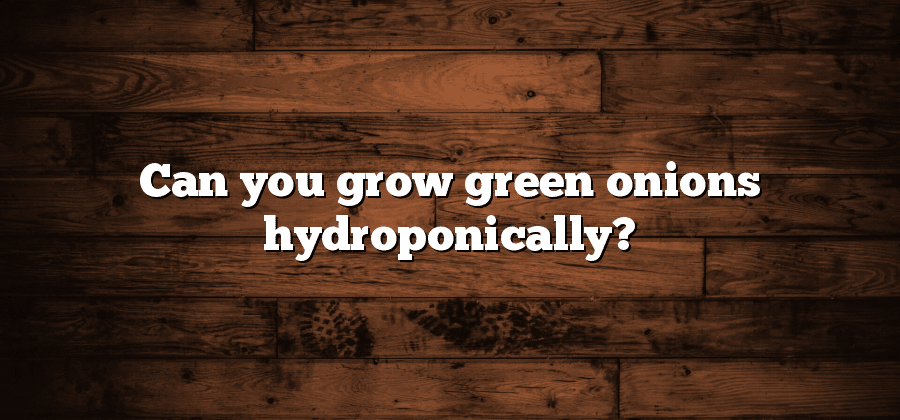Advantages of Growing Green Onions Hydroponically
The practice of growing green onions hydroponically offers several distinct advantages over traditional soil-based cultivation methods. Firstly, hydroponics allows for precise control over the nutrients and water provided to the plants, ensuring that they receive an optimal balance for growth. This eliminates the variability and potential for nutrient deficiencies often associated with soil-based growing.
Additionally, growing green onions hydroponically eliminates the need for soil, reducing the risk of soil-borne diseases and pests. With hydroponics, the plants are suspended in a nutrient-rich solution that provides all the necessary elements for healthy growth. This not only promotes healthier plants but also minimizes the use of pesticides and herbicides, making hydroponic green onions a more environmentally friendly option. Moreover, hydroponic systems can be set up in smaller spaces, making them ideal for urban gardening or those with limited outdoor areas.
Hydroponic System Requirements for Green Onions
To ensure successful growth of green onions in a hydroponic system, there are several key requirements that need to be met. First and foremost, a suitable hydroponic system should be chosen. There are various types available, ranging from deep water culture to nutrient film technique, and each has its own advantages and disadvantages. It is important to select a system that is well-suited to the specific needs of green onions, taking into consideration factors such as space, budget, and the desired yield.
In addition to the hydroponic system, certain environmental conditions must be maintained to promote the healthy growth of green onions. Lighting is one critical factor, as green onions require a minimum of 12-16 hours of light per day for optimal growth. This can be achieved using artificial grow lights, such as LED or fluorescent bulbs, which should be positioned at an appropriate distance from the plants to ensure balanced light distribution. Temperature and humidity levels also play a crucial role, with green onions thriving in temperatures between 18-25°C (64-77°F) and humidity levels around 50-70%. Constant monitoring and adjustment of these conditions will help create an ideal environment for the hydroponic cultivation of green onions.
Selecting the Right Green Onion Varieties for Hydroponic Growth
Selecting the right green onion varieties for hydroponic growth is essential for a successful harvest. When choosing the varieties, it is important to consider their suitability for hydroponic systems, as not all types of green onions thrive under these conditions.
One factor to consider is the size of the green onions. Some varieties, such as Tokyo Long White or Evergreen Bunching, are known for their slender, elongated shape, making them ideal for hydroponic cultivation. These varieties take up less space in the system, allowing for higher planting densities and increased yield. Additionally, their tall, upright growth habit makes them easier to manage and harvest. On the other hand, larger varieties, such as White Lisbon or Red Welsh, may still be grown hydroponically, but they require more space and careful pruning to ensure optimal growth and prevent overcrowding in the system.
Preparing the Hydroponic Solution for Green Onions
To ensure successful growth of green onions in a hydroponic system, it is crucial to prepare the right hydroponic solution. This solution acts as the nutrient-rich water that will provide the necessary minerals and elements for the plants to thrive. The preparation of this solution involves understanding the nutrient requirements of green onions and creating a balanced mixture that meets those needs.
First and foremost, it is important to note that green onions require high levels of nitrogen for optimal growth. Nitrogen is essential for the development of leaves and stems, which are the predominant parts of green onions. Therefore, the hydroponic solution should be formulated with a nitrogen-rich fertilizer. However, it is equally important to maintain a balance in the nutrient levels. Excessive nitrogen can lead to vigorous foliage growth at the expense of root development, compromising the overall health of the plant. Therefore, it is necessary to choose a hydroponic fertilizer blend specifically designed for leafy vegetables like green onions and follow the manufacturer’s instructions for the appropriate dilution and application rate. By carefully preparing the hydroponic solution with the right balance of nutrients, growers can ensure that their green onions receive the ideal nutrition for vigorous growth and a bountiful harvest.
Planting Techniques for Green Onions in a Hydroponic System
Planting techniques for green onions in a hydroponic system play a crucial role in ensuring their successful growth and harvest. When it comes to choosing the right method for planting green onions, the most common approach in hydroponics is the nutrient film technique (NFT). In this technique, shallow channels with a constant flow of nutrient-rich water are used to support the plants. The green onion seedlings are carefully placed in the channels, allowing their roots to receive consistent access to water and nutrients.
Proper spacing is an essential consideration when planting green onions in a hydroponic system. It is best to leave around 1-2 inches of space between each seedling to allow for optimal growth and airflow. Additionally, regularly monitoring the pH and nutrient levels in the hydroponic solution is crucial. Green onions prefer slightly acidic conditions, ideally around 6.0-6.5 pH. By maintaining a balanced nutrient solution, the plants can maximize their nutrient absorption and overall growth potential. With the right planting techniques and attention to detail, green onions can thrive in a hydroponic system, providing a continuous supply of fresh and flavorful herbs.






